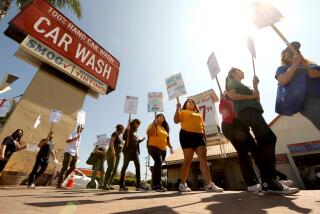High Court Ruling Stirs Debate on Strikes
- Share via
Despite smiles of delight from management and angry protests from organized labor, there will be little effect, other than a psychological one, from last week’s 5-4 Supreme Court ruling that unions may not fine or otherwise discipline members who resign so that they can cross picket lines.
Charles Bakaly and Joseph Herman, two management attorneys in Los Angeles, reflected the view of most corporate executives when they hailed the decision as one that will encourage union workers to cross their own picket lines and encourage management to try to operate during a strike. Herman noted, however, that, “actually, these days management doesn’t need much encouragement to keep operating during strikes.”
Murray Seeger, an AFL-CIO spokesman, denounced the ruling as yet another government incursion into the freedom of union members to write their own rules and regulations.
“While the rest of the economy is being deregulated, unions are being saddled with new regulations and government interference,” he said. “We’re the only segment of society being re-regulated by the Reagan Administration.”
Many commentators on labor relations have argued that the ruling was a significant setback for unions and could widen the rifts between union leaders and members.
The National Labor Relations Board, dominated by conservative Reagan appointees, has been making decisions that generally favor management. In fact, the Supreme Court upheld a pro-management ruling that the board made two years ago in a case involving the Pattern Makers Union.
If the ruling does have any significant effect, it would be to increase anti-union attitudes by implying that union leaders call strikes against the members’ wishes and then threaten them with fines if they act as strikebreakers.
In reality, however, unions do not call strikes without the approval of a majority of the members. Moreover, only a few unions impose fines on members who cross picket lines, and in those cases members who disagree with the majority can resign from the union before a walkout begins.
Even members who do not resign before a strike begins are seldom deterred from crossing picket lines because the NLRB has held that employers can pay any legal fees that the strikebreakers may incur. In many cases, employers have extended that ruling and paid fines as well.
The boss isn’t supposed to try to induce strikers to cross picket lines by loudly proclaiming a promise to pay any union fines, but strikebreakers generally have little trouble winning such assurances.
William R. Robertson, head of the Los Angeles County AFL-CIO, says that the vast majority of union members who refuse to cross picket lines feel that, “when they become members, they take a pledge to uphold their union and to act with (the) majority, and they want to live up to their pledges. The threat of fines has relatively little impact.”
While the latest Supreme Court ruling doesn’t have great significance, there is another, potentially far more important, question now before the NLRB: Can unions, particularly in construction and trucking, legally seek a contract clause prohibiting a company from setting up a separate, non-union subsidiary?
More and more construction firms have separate union and non-union operations. Unions are trying to negotiate contract provisions that would prohibit the practice. In addition, a measure before the U.S. House of Representatives would curb the trend toward so-called double-breasted operations.
However, the companies argue that creation of independent, non-union operations is legitimate. They are strongly opposing the measure before Congress and have requested that Rosemary Collyer, the NLRB’s new general counsel, prohibit unions from trying to end this practice.
The board itself will have to rule on the issue, which could then be put before the courts.
Given the attitude of the NLRB and the Supreme Court toward organized labor these days, the unions have little reason to be optimistic.
Carpenters OK Pay Freeze
Southern California’s unionized carpenters have agreed to give up a $1.15-an-hour pay raise that was to have gone into effect this week. The decision is part of a remarkable effort by construction workers across the nation to halt and, if possible, reverse the growth of non-union companies.
Paul Miller, head of the Carpenters Union District Council in Los Angeles, said the carpenters have agreed to extend their current contract until 1988 and will not get their raise until next July 1. The year after, they will get an additional $1 an hour, and then, in 1988, 50 cents more an hour.
The one-year pay freeze affects about 30,000 carpenters who now earn $17.14 plus fringes of about $7.30.
Southern California cement masons have negotiated a similar contract extension, and other crafts in this area are considering them.
Not all of the 4.4 million union construction workers are accepting the latest concessions. The contract for the Laborers Union in this area, for instance, expires next June 30; members took their $1-an-hour pay boost as scheduled this week, bringing them to $14.42 plus fringes of $7.78.
But there is clearly a trend of concessions in the industry.
Richard Pozzo, former head of the Associated General Contractors--a bargaining arm for the industry--and an executive of Los Angeles-based Pozzo Construction Co., said joint efforts by labor and management to make unionized firms more competitive seem to be effective.
The wage freeze this year will help his own company, formed in the early 1920s, get new business, he said. In addition, he said, such labor-management cooperation discourages anti-union sentiment and helps the company keep “skilled, steady, productive craftsmen.”
In the late 1970s, union construction workers, whose skills and relatively high income had earned them the nickname “aristocrats of labor” for many decades, began agreeing with a management contention that rigid work rules and hefty increases in wages and benefits were pricing them out of the market.
The trend toward looser work rules and reduced or frozen wages was accelerated by the deep recession that hit the industry in the last few years and by blunt advice from union leaders that workers would have to restrain contract demands and even make concessions to avoid the prospect of more non-union competition.
As a result, the dramatic gains made by non-union construction companies seem to have been slowed, although associations representing many non-union contractors deny that.
In the Los Angeles area, for example, the percentage of work done by unionized construction workers dropped from about 67% in 1977 to about 50% in 1981 but has held generally steady since then.
Joe Maloney, secretary-treasurer of the AFL-CIO building trades department, said that the success of the unions’ campaign against non-union competition varies by community and industry segment but that, “overall, we are making slow but steady progress.”
The unions’ campaign is far from over.
The AFL-CIO recently started mailing about 30,000 “Market Recovery Guide” books to local and regional construction union officials, urging them to look at ways of “adjusting contracts that make common sense.”
Robert A. Georgine, president of the department, says the guidebooks can help develop a “framework for new relationships between union and management and show the way toward further growth (in the unionized sector of the construction industry).”
The book urges establishment of a “continuing dialogue” between unions and management and indicates ways to increase productivity by eliminating restrictive work rules, standardizing holidays and reconsidering limits on crew size.
Maloney says the idea behind the guidebooks “is part of a long-term process we have begun, not to help our unions apply a Band-Aid to the wounds afflicted by non-union contractors on union workers but to make new gains for our members and bring our unions to the non-union workers themselves.”
Teamsters Pension Dispute
The first serious fight between management and union trustees of the $5.5-billion Western Conference of Teamsters pension fund has been resolved, and workers covered by the plan will get a hefty 25% increase in their retirement benefits.
The fund, which has more assets than any other private pension program, was created 30 years ago, and, until recently, management and union trustees had worked in relative harmony.
But last April, management trustees went to court to, among other things, prevent what they said were attempts by international officers of the union, including Teamsters President Jackie Presser, to interfere with the decisions of the fund’s union trustees.
Several months ago, trustees started grappling with how best to use the fund’s large reserves. Management trustees agreed that retirees should get an increase in benefits, but they argued that a significant portion of the funds should go to reducing the plan’s “unfunded liability,” which is the amount needed to pay off all pension benefits in the unlikely event that the fund ever collapsed. The union representatives preferred to put more in the hands of retirees and to pay off the liability more slowly.
The controversy ended with a joint statement from Owen L. Bennett, representing management, and Joseph W. Ballew of the union providing for significant benefit increases and promises of close cooperation in the future.
For the workers, the agreement resulted in the largest increase in benefits ever given to participants since the fund began three decades ago.
A truck driver who could have expected to retire at age 62 after 30 years of service with a pension of $999 a month in addition to Social Security will now get $1,248 from the fund.
The Teamsters trustees also overcame management resistance to a union proposal to hire other lawyers and actuaries for “second opinions” on issues debated by the fund trustees. Now, they use one law firm and one actuarial firm.
The unfunded liability is actually being reduced fairly rapidly. Two years ago, the unfunded liability was $1.5 billion. Just a few months ago, it was down to $650 million and now is estimated to be only $400 million. It should be eliminated by 1988.
Employers now contribute $1.26 an hour to the pension fund per worker. Under a recently negotiated national trucking industry contract, the employers will increase their contribution by 22 cents an hour.
More to Read
Get the L.A. Times Politics newsletter
Deeply reported insights into legislation, politics and policy from Sacramento, Washington and beyond. In your inbox three times per week.
You may occasionally receive promotional content from the Los Angeles Times.










